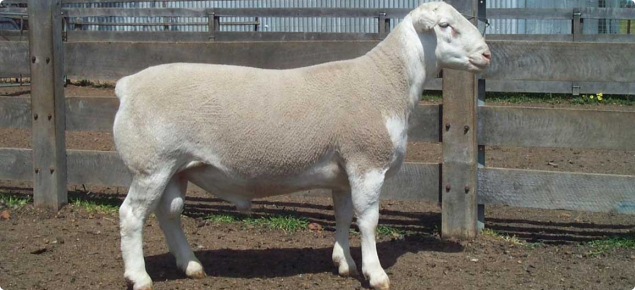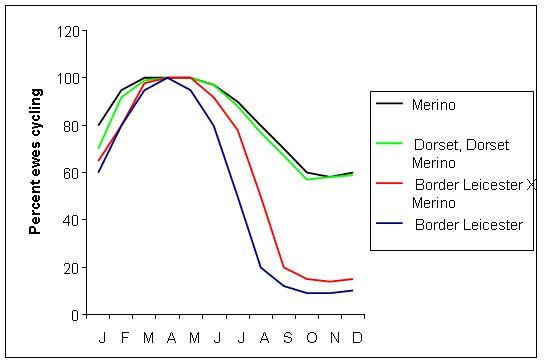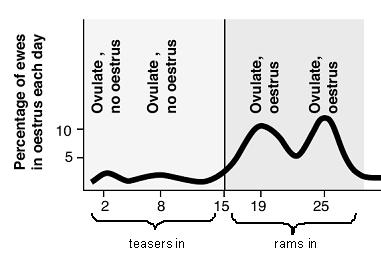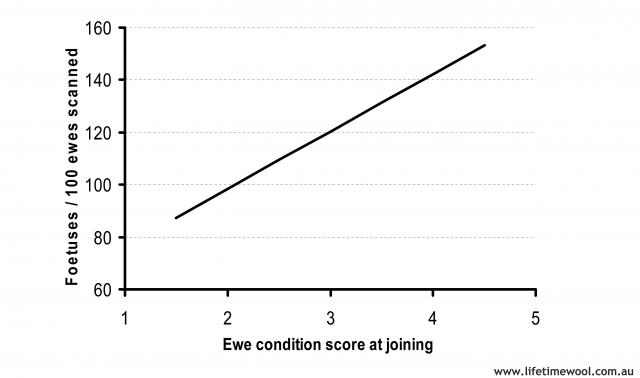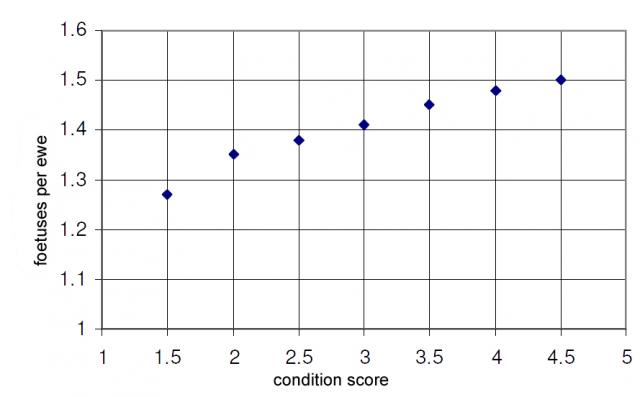Introduction
Key tactical decisions around ewe and ram health and nutrition should be made prior to joining. This should ideally start eight weeks before joining as the impact of nutrition, shearing and teasing take time to influence joining success.
The majority of the ewes in Western Australia (WA) are seasonal breeders. The spontaneous cycling in Merinos and breeds such as Poll Dorset are least affected by day length. Breeds such as Border Leicesters and other British breeds are most affected by day length, as shown in the graph below. By the end of January most ewes are cycling spontaneously every 17 days and a joining period of two cycles or five weeks is recommended.
Prior to the natural breeding season, ewes can be stimulated to cycle by the introduction of males, called the ‘ram effect’, but often ewes will have a false oestrus and will therefore have to cycle again before falling pregnant. For this reason, teasing ewes for 14 days prior to rams-in is recommended when joining before February (See the next page for joining out of season and using teasers).
Ewe nutrition is a key to joining success. When ewes are in the right condition at joining, their ovulation rate and the chance of conceiving twins (fecundity) increases. Prejoining nutrition of maiden ewes will drive their ability to cycle and become pregnant.
Ram preparation
The period leading up to joining is important to ensure that rams are healthy and in the best condition possible. Lambing potential is maximised when rams are able to work, and have viable sperm, throughout the joining period.
Preparation should commence at least eight weeks prior to joining because it takes about seven weeks for sperm to develop from initiation to ejaculation. Therefore, treatments to the rams between seven weeks and joining can only influence the proportion of developing sperm which would be delivered after joining has started.
Two actions should be taken prior to mating to ensure success:
- carry out the 'four Ts' health check (teeth, testes, toes and tossle)
- feed high protein and energy grain or pastures for maximum sperm production at least eight weeks before joining.
The four Ts health check
- Teeth — check that the ram has a sound mouth, with teeth and gums in good condition. Check for over bite (parrot mouth) or under bite. These defects are highly heritable and any rams with these defects should be culled.
- Testes and tossle — rams need maximum testes size to work effectively. Testes and epididymides (the long tubes which run up the sides of the testicles) should be firm and have no lumps. Spongy testes can be a sign of disease, poor nutriton or injury.
- Test all rams with unexplained lumps or swellings in the epididymides for Brucella ovis, a bacterium that can drastically reduce ram fertility. Don't crutch or shear rams during this time as infections from cuts, especially to the scrotum, can stop sperm production. Check the penis and the prepuce for any abnormalities or swelling.
- Toes — check and trim any feet as required. Remove, or treat and monitor, any rams with a sign of lameness. Lameness will affect the rams ability to work as well as his output.
Feeding rates for rams pre-joining
To ensure firm, large testes, feed lupins at up to 750 grams per head per day for the eight weeks leading up to joining (feeding rates may be lower if paddock nutrition is very good). Rams should be in at least condition score 3 but no more than condition score 4.
Joining percentage
Ensure you have adequate numbers of rams for joining. Fit, healthy rams should be used at a minimum of 1% (with a minimum four rams per mob). Join mature rams to maiden ewes.
Immature rams tend to have smaller testes size and therefore lower sperm production so a minimum of 2% should be used. With a synchronised joining, or out of breeding season joining, it is safer to use 3%.
Joining out of season and use of teasers
To join ewes outside the spontaneous breeding season, the ‘ram effect’ can be used. For the ram effect to be effective, all ewes must be kept at least one kilometre (km) from any ram (including neighbouring property’s rams) for four weeks before the introduction of teasers or rams. The introduction of teasers/rams to the isolated ewes will induce them to start cycling.
The major benefit of successfully using the ram effect induced by teasers is to get a high proportion of ewes in lamb over a short period of time which results in a more compact lambing. Teasers also stimulate more ewes to come into oestrus.
Teasing for 14 days followed by a 35 day joining is recommended.
Teasers can be testosterone treated wethers (or ewes) or vasectomised rams. If using vasectomised rams, they must be removed at the start of joining; wethers can be left in the mob until the rams are removed, unless they are large and aggressive and likely to compete with rams for ewes. Inject teasers with testosterone seven days prior to being used. Testosterone is available from your veterinarian. Teasers should be used at 1% for 14 days before the entire rams go in. Teasers must be introduced directly to the mob to ensure that all ewes make contact as soon as possible.
If teasers aren’t available, flock rams can be used but a longer joining is recommended (45 days).
Ewe preparation
In WA the average reproductive rate (foetus per 100 ewes joined) is 120%, however, flocks will vary and flocks across years will vary considerably. Nutrition and the ewe's condition score are the greatest determinants of reproduction rate. Therefore, take every opportunity when you have your ewes in the yards to condition score 25 sheep per mob, starting 56 days prior to the start of joining.
Tips for preparation
- Check ewe condition at least a month prior to joining to assess if feeding is required to maintain their condition.
- Check ewes for low condition, udders, poor feet and mouth condition – remove any affected ewes from the main flock.
- Ewes should be in condition score 3+ (good cover of muscle and fat over the short ribs).
- Tease ewes if mating prior to mid January.
- Join for 35 days (two cycles).
What condition should my ewes be in?
The higher the condition score of ewes at joining, the higher the potential number of lambs and the lower the number of dry ewes there will be in a flock. The average response is about 20 extra lambs per 100 ewes for an additional condition score at joining.
Remember it is cheaper to maintain condition rather than to feed supplements to put on weight. If joining is on dry feed, ewes will need to have reached optimum condition before the pastures deteriorate or stubbles are grazed out.
The higher reproductive rate is due to fewer dry ewes and more ewes conceiving twins. At condition score 3, there should be no more than 10% dry ewes in most Merino flocks and less than 5% dry ewes in cross-bred flocks.
In flocks scanning around 120%, half of the lambs born will be twins and less than 5% of the ewes will be dry. View the pregnancy scanning benchmarks in WA to see where your flock's reproduction rate sits.
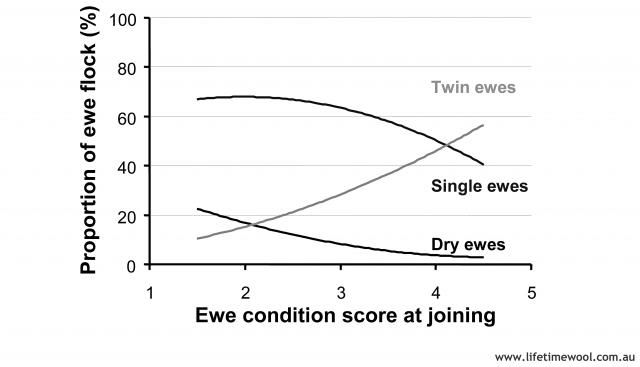
The condition of the ewes should be maintained over the joining period to ensure optimum conception and profitability. Maiden ewes should reach at least 90% of their adult body weight prior to joining to maximise their chances of conception. Ewes less than condition score 2 should either be treated separately to gain condition prior to mating, or not mated at all. Those ewes conceiving in condition score 2 will be unlikely to gain condition over pregnancy and therefore be at risk at lambing.
Flushing or feeding lupins prior to joining
A method to stimulate reproduction rates is to feed ewes 500 grams per head of lupins daily from seven days prior to rams going in and continue for no more than seven days after rams-in. This method can be variable in its response and the cost of feeding lupins to the value of extra lambs needs to be taken into account. Note: ewes are more likely to respond to lupin feeding if they are less than condition score 3 and it is suggested that ewes be fed daily rather than twice weekly or join on ungrazed lupin stubbles. Be prepared to manage the extra twins generated – twinning ewes will need higher nutrition in pregnancy and lactation.
Any ewes stimulated to ovulate when in poor condition (< condition score 2) will be in below optimum condition at lambing and exposed to higher mortality risk.
A much more reliable strategy is to ensure at least 85% of ewes in each mob are above condition score 3 at the start of joining.
The variable responses in reproductive rate between flocks
The response in reproductive rate (foetuses/100 ewes joined) to nutrition varies for different flocks. The key factors affecting the responsiveness of flocks are their genetics and time of lambing. Later lambing flocks are more responsive.
It is critical to understand the responsiveness of your flock's reproductive rate (foetus/100 ewes joined) to increased ewe condition at joining so that you can make feeding decisions leading up to joining.
Whether your ewe flock is responsive (+30 lambs/condition score) or less responsive (+10 lambs/condition score) to improving condition score at joining, can affect the profitability of ewe management options approaching joining, depending on the value of extra lambs to your enterprise.
To determine the response of your flock requires condition scoring a flock at joining, recording the score of individual ewes and then recording their pregnancy status (dry, single bearing or twin bearing) at pregnancy scanning. Averaging the pregnancy status of ewes in each condition score at joining will show a relationship like the one below. Drawing a straight line (trend line) through the points will result in a sloped line. A steep slope indicates a very responsive flock to nutrition at joining. A shallow sloped line indicates a flock that isn’t responsive to nutrition at joining.
The difference between the reproductive rate at condition score 2 and condition score 3 (for example 0.35) means that you can expect an increase of 35 foetuses per 100 ewes scanned for every increase of one condition score.

